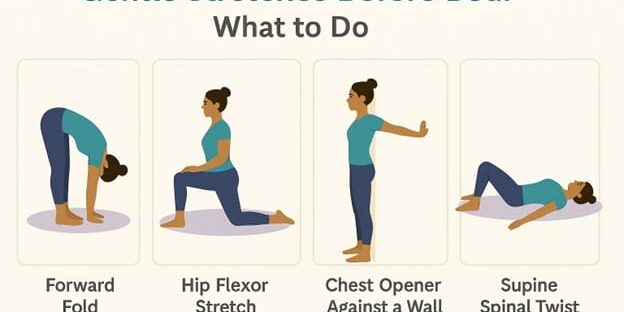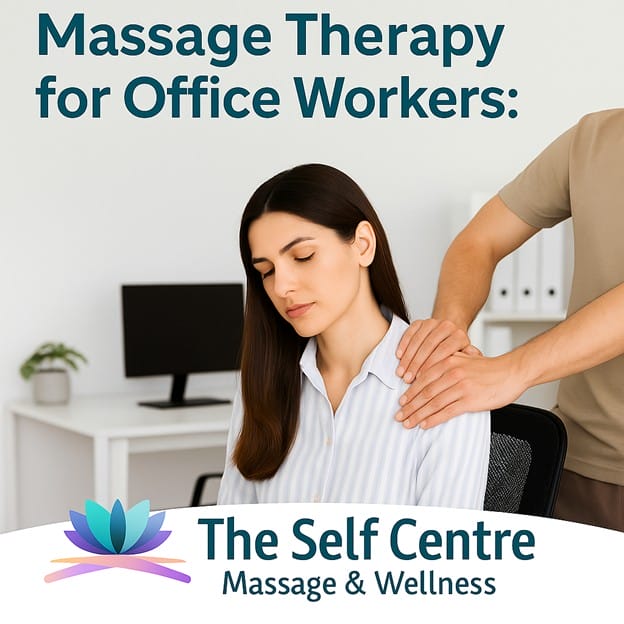
Sitting All Day in Edmonton? Here’s Why Massage Therapy Could Save Your Body
You sit. You type. You Zoom.
And repeat.
For a lot of office workers, that’s the entire day. Sounds simple, right? Until the neck tension kicks in. The headaches. The tight hips. The brain fog.
Truth is, that comfy-looking office chair might be slowly wrecking your body—and your focus.
But here’s the good news:
Massage therapy is one of the simplest, smartest ways to reverse the damage and feel like a human again.
Let’s break it all down.
Is Your Desk Job Wrecking Your Body?
Let’s be honest—sitting at a desk all day might not look hard on the outside, but internally, it’s quietly taking a toll.
According to the Canadian Centre for Occupational Health and Safety, prolonged sitting is linked to:
- Neck and back strain
- Hip tightness and poor flexibility
- Poor circulation
- Increased fatigue and reduced productivity
And in our Edmonton clinic, we see the same patterns over and over:
- Chronic neck and shoulder tension – You might not even realize how bad it is… until your RMT touches that one spot and your whole body jumps.
- Lower back pain – Especially common if you’ve got tight hip flexors or weak core muscles.
- Wrist pain or carpal tunnel symptoms – All that mouse-clicking and typing adds up—fast.
- Tension headaches and eye strain – Blame forward head posture, stress, and too much screen time.
- Restless sleep – When your nervous system stays tense, deep sleep is the first thing to go.
- Brain fog and burnout – You’re not lazy—you’re stuck in a posture that’s slowing your system down.
“I didn’t even do anything… and somehow I still feel like I’ve been hit by a truck.”
Sound familiar?
That’s your body waving the white flag. Massage therapy is one of the fastest, most effective ways to reset and get back to feeling like yourself again—without medication or guesswork.
Massage Therapy: Not a Luxury—A Smart Strategy
Let’s bust the myth right now: massage therapy isn’t just for spa days and self-care Sundays.
It’s a science-backed, results-driven, performance-boosting tool.
It’s also one of the smartest investments you can make in your long-term health, productivity, and mental clarity—especially if your job keeps you glued to a chair for most of the day.
When done by a registered massage therapist in Edmonton—and done regularly—massage helps your body bounce back from the daily grind of sitting, typing, scrolling, and Zoom-ing.
Here’s how it works (and why it works so well for office professionals like you):
✔️ Releases Muscle Tension Where You Hold It Most
Your muscles are probably holding stress you don’t even know about. Until someone presses just right and you almost fall off the table from the shock of how tight you are.
Massage therapy targets those chronically tight areas that desk jobs abuse the most:
- Your neck and traps from hunching
- Your shoulders from typing
- Your hips from sitting
- Your lower back from compensating for it all
Your body doesn’t need more movement—it needs the right kind of release. That’s what we do.
✔️ Improves Posture Without You Even Thinking About It
Let’s be honest: no one actually “sits up straight” all day.
Even with the fanciest ergonomic chair and a Post-it note reminder, you’ll still slide into weird positions as the day wears on.
Massage therapy helps fix your posture by rebalancing the muscle groups responsible for holding you upright.
When the tight muscles are released and the underused ones are activated, your body naturally starts sitting and standing straighter—without you having to constantly “remember” to fix it.
It’s not about willpower. It’s about working with your body instead of against it.
✔️ Boosts Circulation = More Oxygen, More Focus
Here’s something most people overlook: sitting still reduces circulation.
And when your blood flow slows down, your energy crashes. You feel sluggish. You zone out on calls. You reach for coffee when what your body actually needs is better blood flow.
Massage stimulates circulation throughout your body, especially in areas where blood tends to pool when you’re inactive—like your legs, lower back, and shoulders.
That fresh oxygen and nutrient delivery helps:
- Clear out metabolic waste
- Reduce swelling or inflammation
- Wake up your muscles (and your brain)
- Improve focus, alertness, and mental clarity
TL;DR: better blood flow = better thinking.
✔️ Calms the Nervous System (Yes, It Helps With Stress Too)
Massage therapy isn’t just about fixing physical issues.
It directly affects your nervous system—which is the control centre for everything in your body.
Massage lowers cortisol (your stress hormone) and boosts serotonin and dopamine (your feel-good, focus-enhancing, mood-regulating neurotransmitters).
According to this Harvard Health article, even a single massage session can:
- Reduce stress
- Improve sleep
- Lower anxiety
- Increase feelings of happiness and well-being
And when your nervous system feels safe and supported, everything else works better—your digestion, your immune system, your mood, your focus.
It’s not “just a massage.”
It’s a total body system reboot.
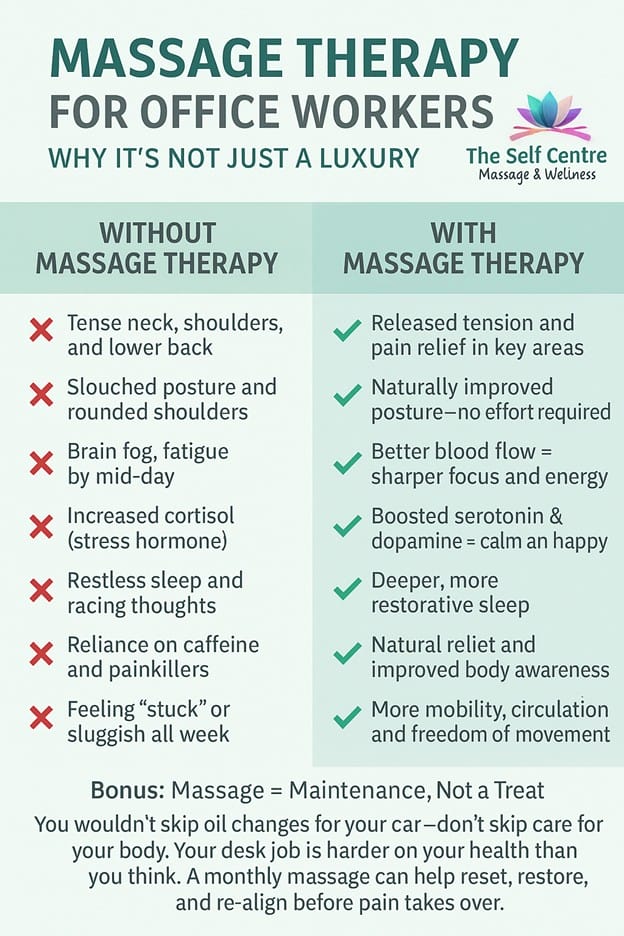
🧍♂️ DIY Relief: 3 Desk-Friendly Techniques to Use Between Sessions
Can’t make it in for a massage today? Don’t worry—we’ve got your back (literally).
Here are 3 super simple, therapist-approved moves you can do right at your desk to relieve tension, improve posture, and keep pain at bay between visits.
✅ 1. Chin Tucks (for Forward Head Posture)
The Problem: “Tech neck.” You’re looking at screens all day, and your head starts jutting forward like a turtle. That creates tension in your upper back and base of your skull.
The Fix:
- Sit tall in your chair with shoulders relaxed.
- Gently pull your chin backward (like you’re making a double chin).
- Hold for 5 seconds.
- Repeat 10–15 times.
Why It Works:
Chin tucks activate the deep neck flexors—small but mighty muscles that stabilize your spine. They counteract the daily pull of gravity (and your screen) on your neck alignment.
Pro Tip: Do these a few times a day, especially after long Zoom calls.
✅ 2. Seated Spinal Twist (for Mid-Back & Core)
The Problem: That achy, stiff feeling between your shoulder blades and down into your low back after sitting all morning.
The Fix:
- Sit up straight.
- Cross your right hand over to your left knee.
- Gently twist your torso to the left, placing your left hand behind you for support.
- Hold for 10 seconds.
- Switch sides.
Why It Works:
Twists wring out the spine, loosen tight paraspinals, and gently re-engage your core muscles. It’s like hitting the “reset” button on your midsection.
Pro Tip: Breathe deeply as you twist—it helps your body let go of tension more easily.
✅ 3. Wrist & Forearm Stretch (for Typing and Mouse Use)
The Problem: That dull, burning tension in your forearms or wrists after a long day of emails, Excel sheets, and scrolling.
The Fix:
- Extend one arm in front of you, palm up.
- Use your opposite hand to gently pull your fingers back and downward.
- Hold for 10–15 seconds.
- Switch sides.
Why It Works:
This stretch opens up the flexor muscles in the forearm, which are constantly shortened when typing or using a mouse. It also helps prevent repetitive strain injuries like carpal tunnel.
Pro Tip: Try this stretch standing with your hand against a wall for deeper release.
For more practical desk-friendly tips and visual posture guidance, check out the OSHA Computer Workstation Checklist — it’s a goldmine of ergonomic advice, especially if you’re working from home or at a non-traditional desk setup.
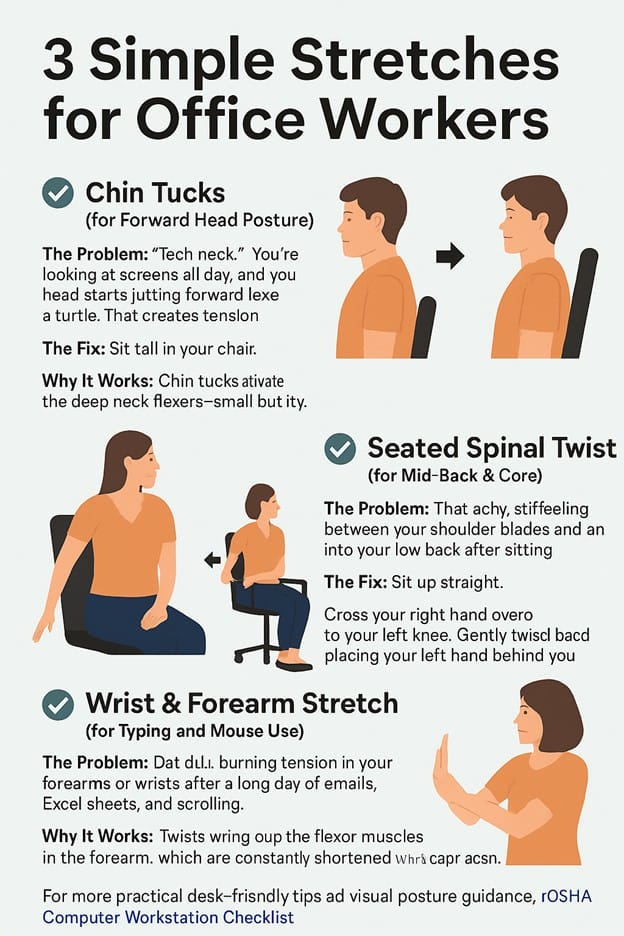
Pro Tips: Maximize Your Massage Sessions Like a Pro
Here’s the thing: massage therapy isn’t magic—it’s part of a bigger strategy.
Yes, your 60-minute session does a lot of heavy lifting. But what do you do between those sessions? That’s what determines how long the benefits last.
So if you’re investing in your body, let’s make it count.
💧 1. Hydrate Afterward (And We Mean It)
Why it matters:
Massage helps release tension—and with it, metabolic waste that builds up in your muscle tissue.
Think of it like cleaning out a sponge. Once all the junk is squeezed out, you need fresh water to rinse and reset.
What to do:
Drink a big glass of water (or two) right after your session. Avoid caffeine and alcohol for a few hours—they dehydrate your body and slow recovery.
Bonus tip: Add a pinch of sea salt or a splash of coconut water to replenish electrolytes naturally.
🧘 2. Stretch Before Bed (Yep, Even 5 Minutes Counts)
Why it matters:
Your muscles repair while you sleep. If they’re tight going into the night, you wake up feeling stiff and sore. Stretching helps “lock in” the benefits of your massage and keeps you mobile.
What to do:
Spend 5–10 minutes on gentle stretches:
- Forward fold
- Hip flexor stretch
- Chest opener against a wall
- Supine spinal twist
Keep it light. Keep it consistent. You’re not training for the Olympics—you’re just helping your body feel better tomorrow than it did today.
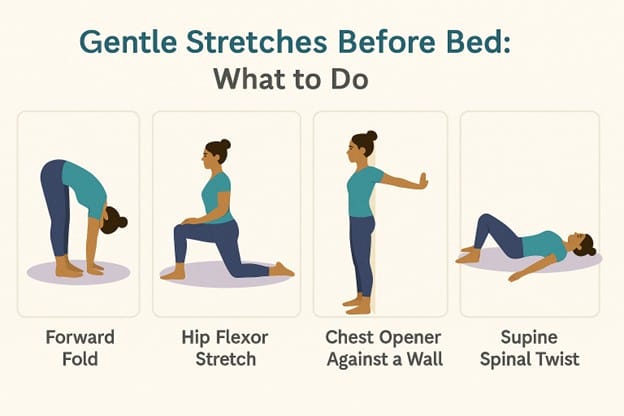
✅ 3. Use a Tennis Ball or Foam Roller Between Sessions
Why it matters:
Trigger points and muscle knots don’t always stay gone after one massage. That’s normal. A little self-maintenance between appointments can go a long way.
What to do:
- Use a tennis ball against a wall for upper back tension
- Roll your glutes, hamstrings, and quads with a foam roller
- Focus on slow, steady pressure—not just rolling back and forth mindlessly
Ask your RMT to show you exactly where and how to apply pressure based on your body’s needs. It takes 3 minutes and can add days of relief.
✅ 4. Book Consistently—Not Just When You’re in Pain
Why it matters:
Waiting until you’re in pain to book a massage is like waiting for your engine light to come on before changing the oil. It’s damage control—not prevention.
What to do:
Aim for a session every 3–4 weeks, especially if:
- You sit for more than 6 hours a day
- You’re under constant stress
- You’ve had issues with posture, tension, or repetitive strain injuries in the past
Think of it as a tune-up—not a repair job. The more consistent you are, the less you’ll need to “undo.”
Serving Edmonton Office Workers
Whether you’re managing projects in the ICE District, answering emails in a coworking space off Whyte Ave, or bouncing between virtual meetings from your home office in Windermere, your body is taking a silent hit—every single day.
Because here’s the truth:
Desk work doesn’t look hard. But it wears you down.
All that sitting. All that staring. All that subtle stress your body holds without you even realizing it.
That’s exactly why massage therapy at The Self Centre Massage & Wellness exists.
We’re here for Edmonton’s office workers, entrepreneurs, remote professionals, and anyone else whose “workday” involves a screen and a seat.
Here’s what we help you do:
✅ Sit with better posture – No more slumping or shoulder hunching
✅ Think more clearly – Blood flow improves, stress drops, focus returns
✅ Sleep more soundly – Your nervous system chills out (finally)
✅ Feel better in your body – Like, actually feel good being in your own skin again
This isn’t a quick fix. It’s the maintenance your body has been quietly asking for.
RMT Care That Works for Your Life
We get it—you’re busy.
That’s why we offer:
- Flexible booking options (evenings and weekends available)
- Convenient South Edmonton location
- Direct billing to most extended health insurance providers
- Personalized treatment plans based on your work habits and tension patterns
- And a down-to-earth, no-pressure vibe (we’re serious about your health, not about spa fluff)
You don’t need to push through.
You just need the right support.
And yes—your insurance probably covers it.
👉 Book your session today and take care of your most important tool: yourself.
Because showing up at your best doesn’t start with a caffeine hit—it starts with a body that actually feels good to live in.
Frequently Asked Questions (FAQ)
Q: Do I need a doctor’s referral for massage therapy in Alberta?
A: Not usually. Most extended health benefits in Alberta cover registered massage therapist (RMT) services without a referral. However, a few insurance providers still require one for reimbursement—so it’s a good idea to check the fine print of your plan. If you do need a referral, your family doctor can usually provide it with a quick visit.
Q: What’s the best massage style for office workers?
A: That depends on what your body needs—but for most desk-bound professionals, we recommend:
- Deep tissue massage – for long-term muscle tension and “knots”
- Swedish massage – for full-body relaxation and circulation support
- Myofascial release – for improving range of motion and postural balance
Not sure what to choose? No problem. Our RMTs will ask the right questions and adjust your treatment on the spot to make sure you’re getting exactly what you need.
Q: I’ve never had a massage before. Will it hurt?
A: Not at all. A good massage should feel therapeutic—not painful. We always start at a gentle pressure and increase it only if you’re comfortable. You’re in control, and we check in with you throughout the session.
If you’re nervous or unsure what to expect, we’ll walk you through everything before we begin.
Q: Can massage therapy really help with posture or alignment?
A: Yes! While massage isn’t a magic fix for posture, it helps release the tension patterns that pull you out of alignment. Think of it like clearing the way so your body can return to a more natural, upright position.
Combined with the right stretches and ergonomics, massage is one of the best tools you can use to correct posture over time—especially if you sit for long hours.
Q: How do I book an appointment?
A: Easy. Just visit theselfcentre.com and use our online booking tool to choose your service, therapist, and time slot. Prefer to call or walk in? We’re happy to help either way—our front desk team is friendly and fast.
Don’t forget: we offer direct billing to most major insurance plans.


